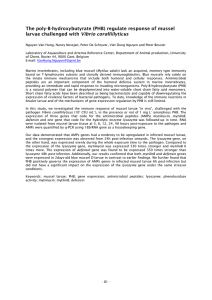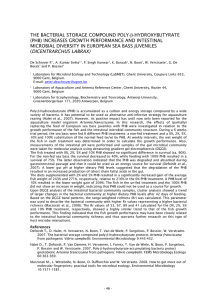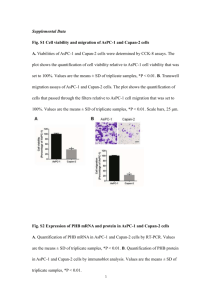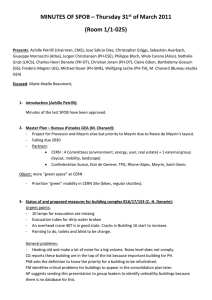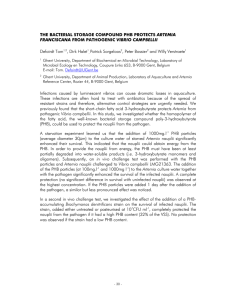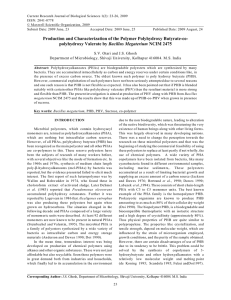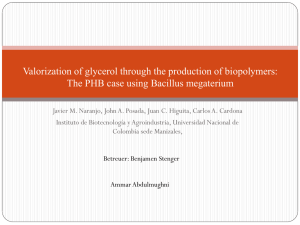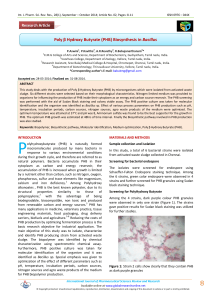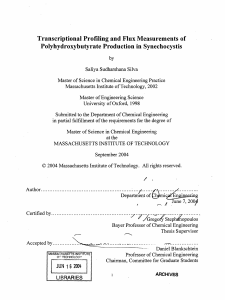POLY-β-HYDROXYBUTYRATE (PHB) REGULATES THE IMMUNE RESPONS Vibrio coralliilyticus
advertisement
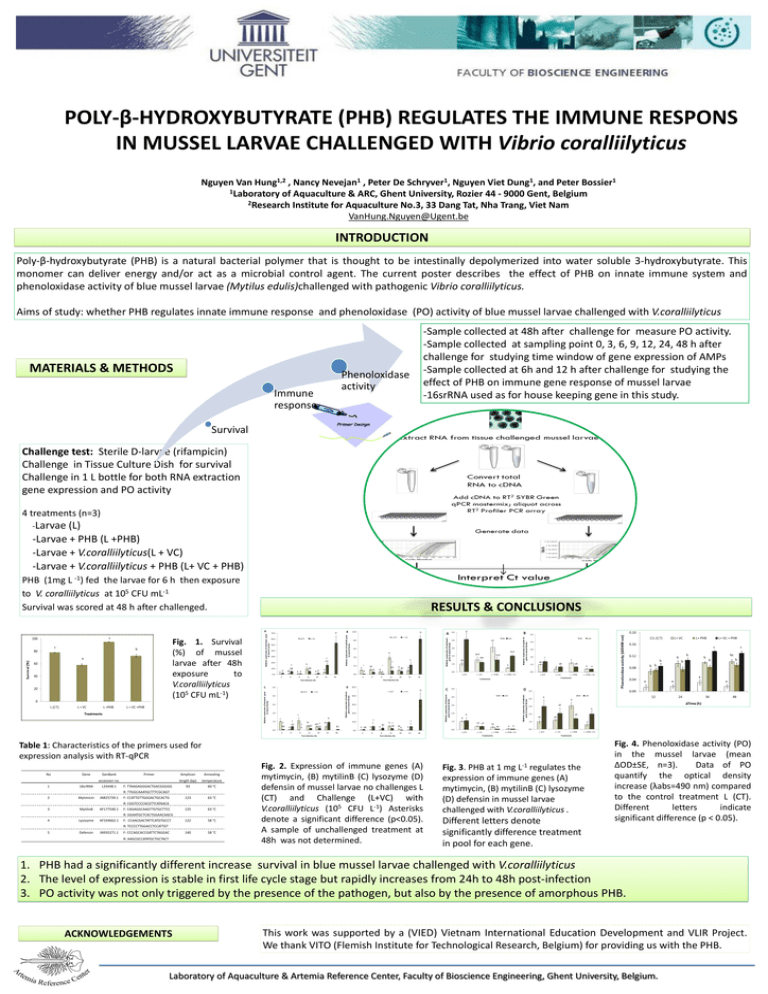
POLY-β-HYDROXYBUTYRATE (PHB) REGULATES THE IMMUNE RESPONS IN MUSSEL LARVAE CHALLENGED WITH Vibrio coralliilyticus Nguyen Van Hung1,2 , Nancy Nevejan1 , Peter De Schryver1, Nguyen Viet Dung1, and Peter Bossier1 1Laboratory of Aquaculture & ARC, Ghent University, Rozier 44 - 9000 Gent, Belgium 2Research Institute for Aquaculture No.3, 33 Dang Tat, Nha Trang, Viet Nam VanHung.Nguyen@Ugent.be INTRODUCTION Poly-β-hydroxybutyrate (PHB) is a natural bacterial polymer that is thought to be intestinally depolymerized into water soluble 3-hydroxybutyrate. This monomer can deliver energy and/or act as a microbial control agent. The current poster describes the effect of PHB on innate immune system and phenoloxidase activity of blue mussel larvae (Mytilus edulis)challenged with pathogenic Vibrio coralliilyticus. Aims of study: whether PHB regulates innate immune response and phenoloxidase (PO) activity of blue mussel larvae challenged with V.coralliilyticus MATERIALS & METHODS Immune response Phenoloxidase activity -Sample collected at 48h after challenge for measure PO activity. -Sample collected at sampling point 0, 3, 6, 9, 12, 24, 48 h after challenge for studying time window of gene expression of AMPs -Sample collected at 6h and 12 h after challenge for studying the effect of PHB on immune gene response of mussel larvae -16srRNA used as for house keeping gene in this study. Survival Challenge test: Sterile D-larvae (rifampicin) Challenge in Tissue Culture Dish for survival Challenge in 1 L bottle for both RNA extraction gene expression and PO activity 4 treatments (n=3) -Larvae (L) -Larvae + PHB (L +PHB) -Larvae + V.coralliilyticus(L + VC) -Larvae + V.coralliilyticus + PHB (L+ VC + PHB) PHB (1mg L -1) fed the larvae for 6 h then exposure to V. coralliilyticus at 105 CFU mL-1 Survival was scored at 48 h after challenged. RESULTS & CONCLUSIONS Fig. 1. Survival (%) of mussel larvae after 48h exposure to V.coralliilyticus (105 CFU mL-1) Table 1: Characteristics of the primers used for expression analysis with RT-qPCR No Gene GenBank Primer accession no. 1 18srRNA L33448.1 F: TTAAGAGGGACTGACGGGGG Amplicon Annealing length (bp) temperature 93 60 °C 123 63 °C 125 63 °C 122 58 °C 140 58 °C R: TTGGCAAATGCTTTCGCAGT 2 Mytimicin JN825739.1 F: CCATTGTTGGGACTGCACTG R: CGGTCCCCACGTTCATAACA 3 MytilinB AF177540.1 F: CAGAGGCAAGTTGTGCTTCC R: GGAATGCTCACTGGAACAACG 4 Lysozyme AF334662.1 F: CCAACGACTATTCATGTGCCT R: TCCCCTTGGACCTCCATTGT 5 Defensin JN935271.1 F: CCCAGCACCGATTCTAGGAC R: AAGCGCCATATGCTGCTACT Fig. 2. Expression of immune genes (A) mytimycin, (B) mytilinB (C) lysozyme (D) defensin of mussel larvae no challenges L (CT) and Challenge (L+VC) with V.coralliilyticus (105 CFU L-1) Asterisks denote a significant difference (p<0.05). A sample of unchallenged treatment at 48h was not determined. Fig. 3. PHB at 1 mg L-1 regulates the expression of immune genes (A) mytimycin, (B) mytilinB (C) lysozyme (D) defensin in mussel larvae challenged with V.coralliilyticus . Different letters denote significantly difference treatment in pool for each gene. Fig. 4. Phenoloxidase activity (PO) in the mussel larvae (mean ∆OD±SE, n=3). Data of PO quantify the optical density increase (λabs=490 nm) compared to the control treatment L (CT). Different letters indicate significant difference (p < 0.05). 1. PHB had a significantly different increase survival in blue mussel larvae challenged with V.coralliilyticus 2. The level of expression is stable in first life cycle stage but rapidly increases from 24h to 48h post-infection 3. PO activity was not only triggered by the presence of the pathogen, but also by the presence of amorphous PHB. ACKNOWLEDGEMENTS This work was supported by a (VIED) Vietnam International Education Development and VLIR Project. We thank VITO (Flemish Institute for Technological Research, Belgium) for providing us with the PHB. Laboratory of Aquaculture & Artemia Reference Center, Faculty of Bioscience Engineering, Ghent University, Belgium.
